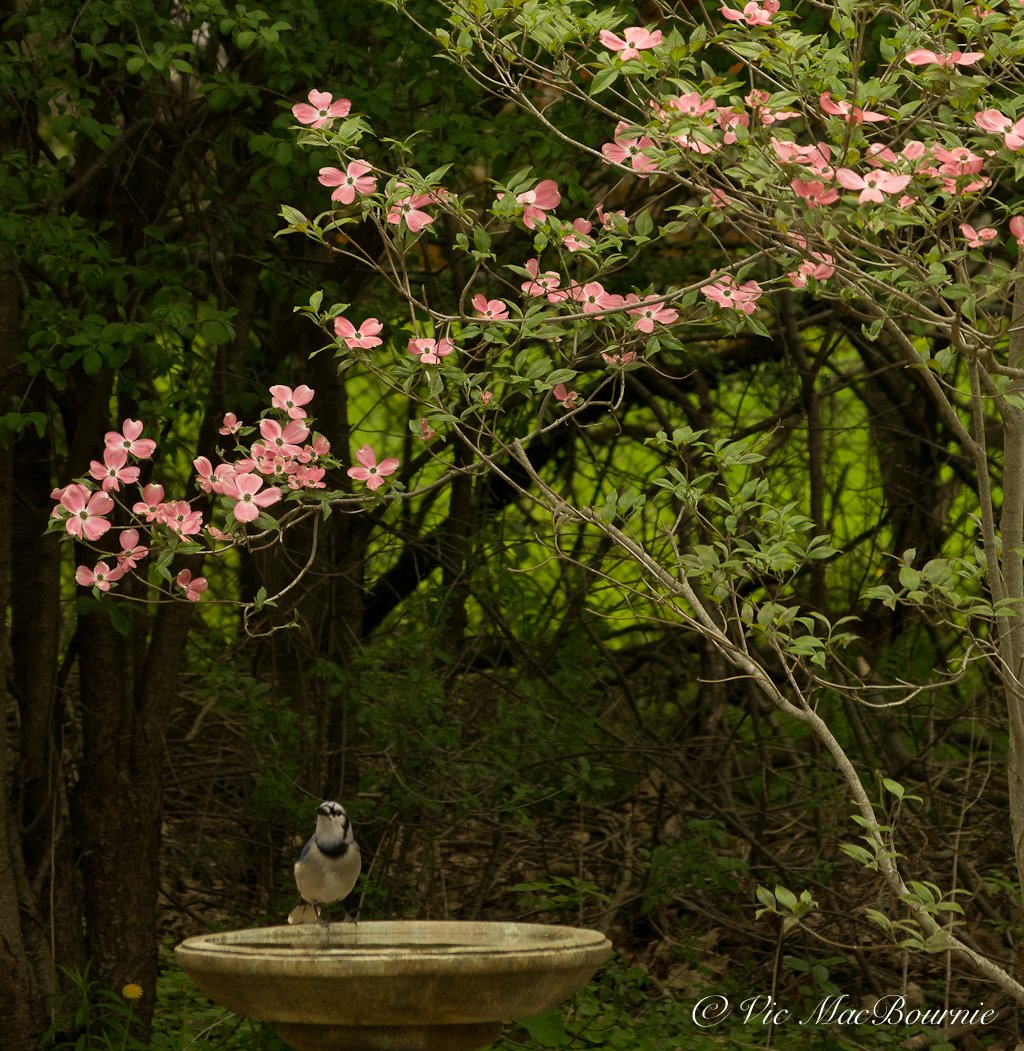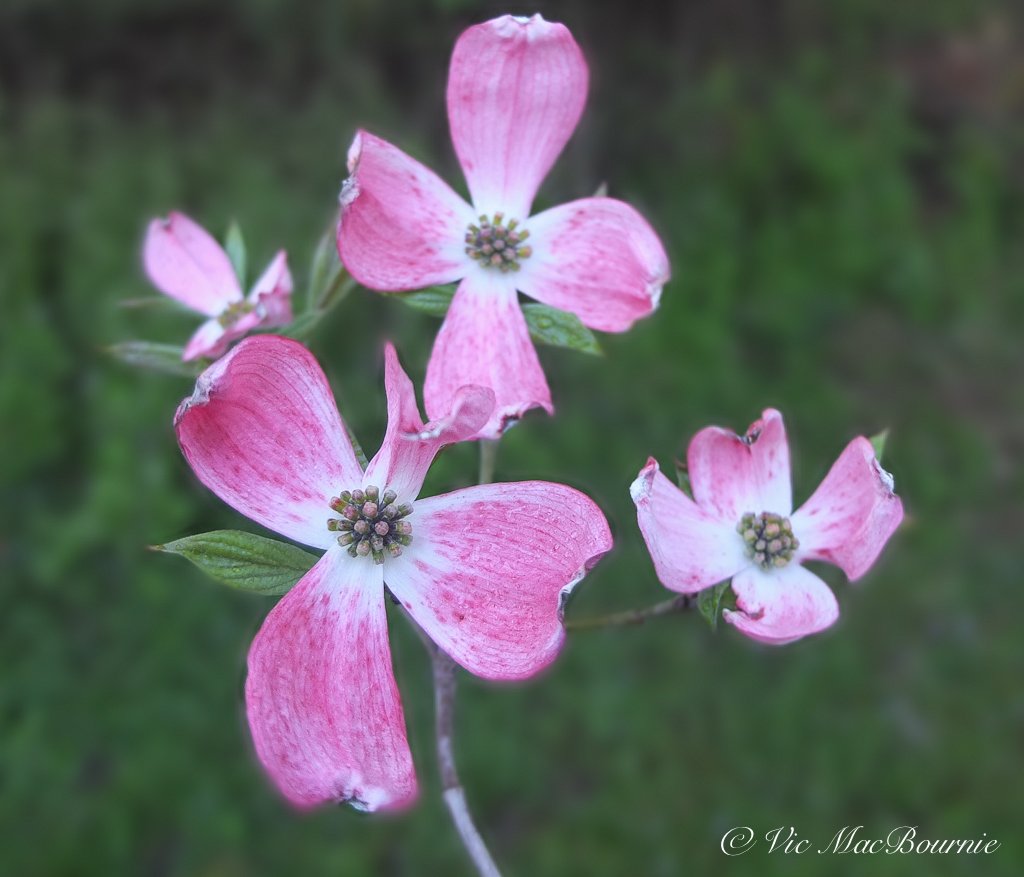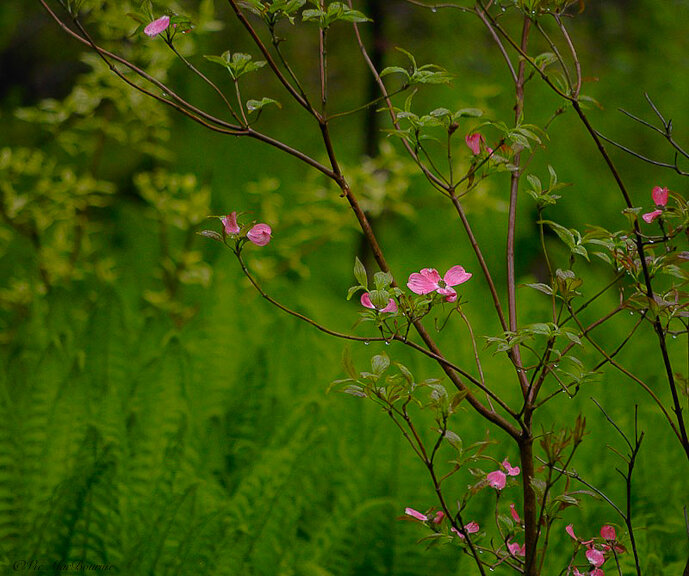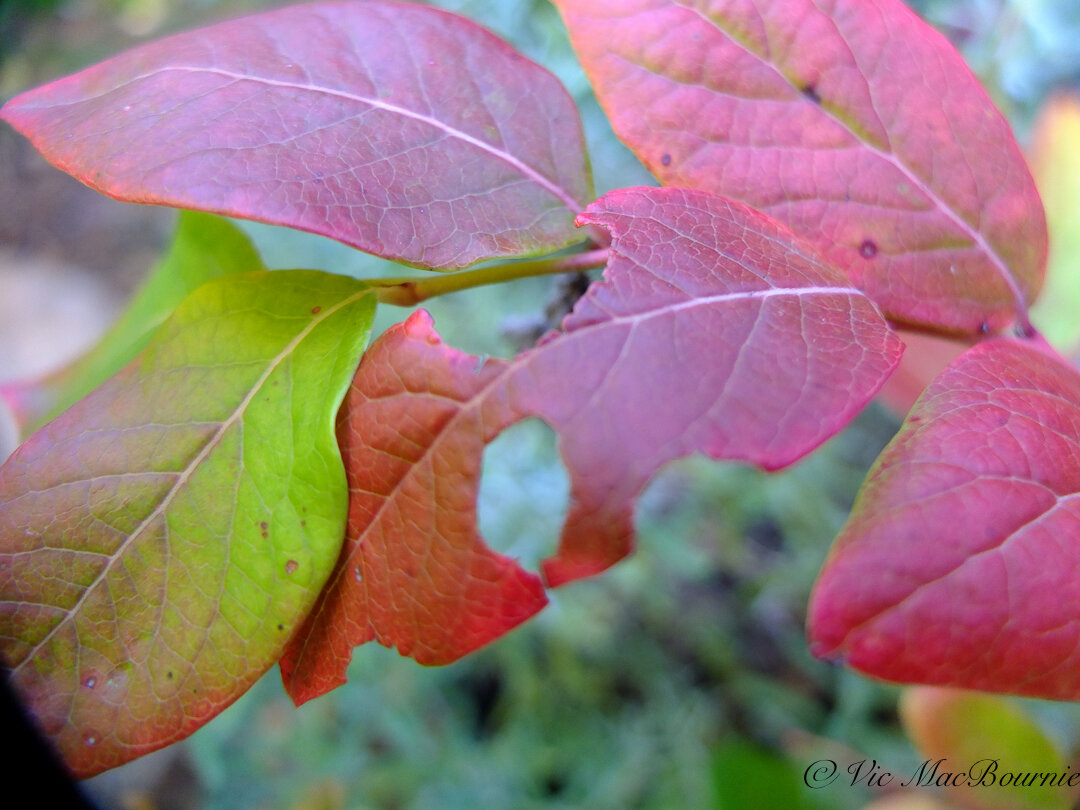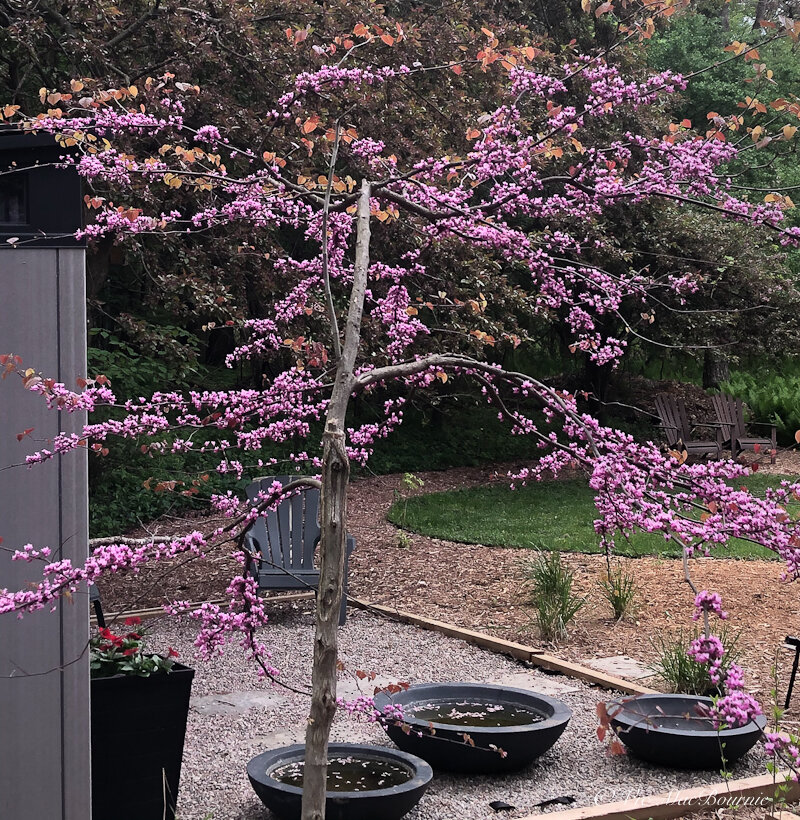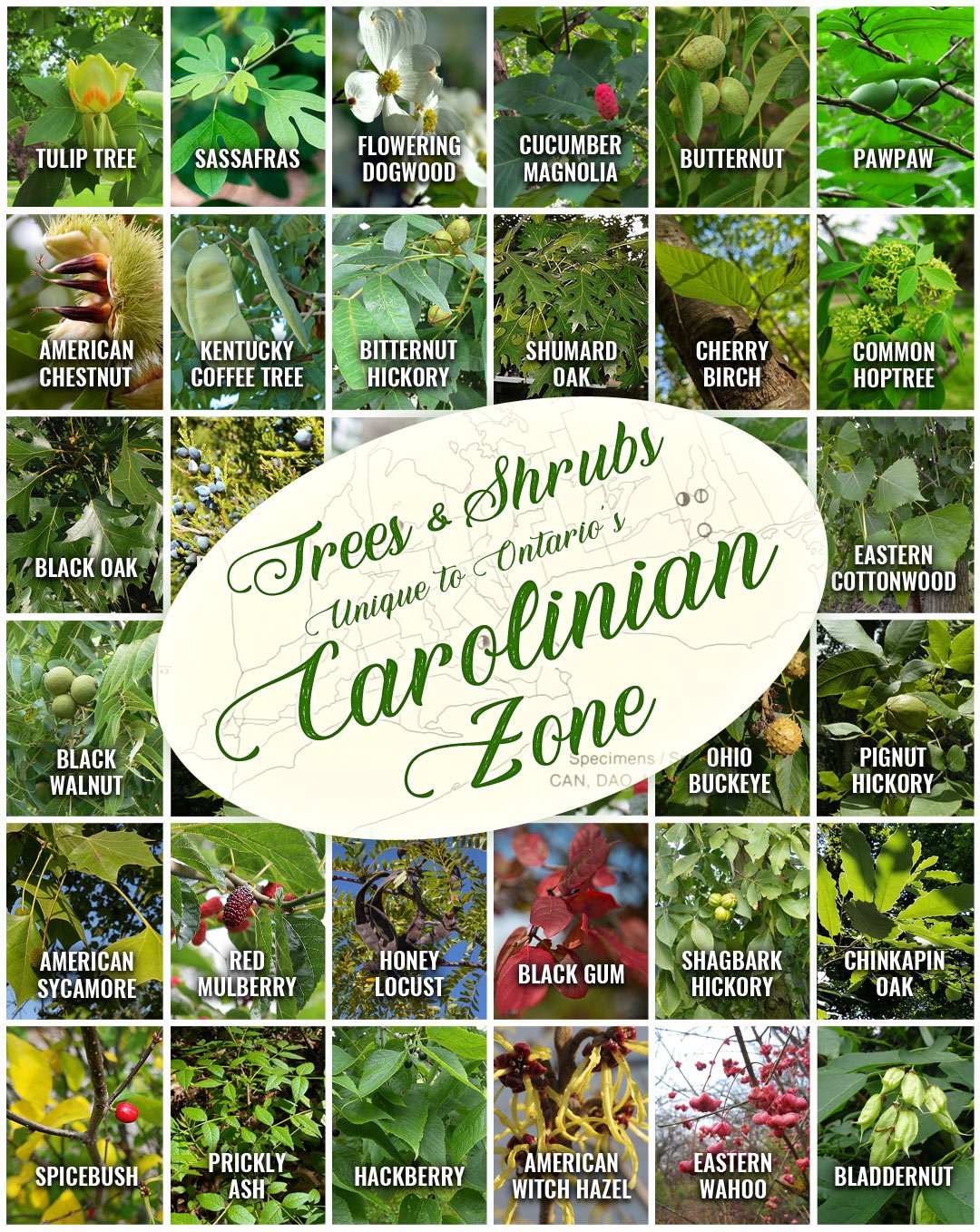Flowering Dogwood: The queen of the Woodland garden
The flowering dogwood is an icon of the American landscape with its spectacular spring flowers followed by red berries that birds cannot get enough of as they ripen.
The Flowering Dogwood (Cornus Florida) combines everything a gardener could want in a backyard tree.
If you are lucky enough to live in a region where you can grow this iconic native American flowering tree, whether it’s in your front as a specimen tree or as an understory tree in the backyard woodland or shade garden, you should waste no time sourcing one or even several for your front and back gardens.
In our backyard woodland garden, we have several that fill the garden with showy spring flowers followed by berries in summer and outstanding fall colour.
Its native range is New England south to northern Florida, west to the Mississippi and even beyond. In Canada it finds its range in Southern Ontario’s Carolinian zone.
In the cooler growing zones found in Northeastern U.S. and parts of Canada in zones 5-6 for example, Dogwoods can take more sun than the hotter zones farther south where they are best grown in light to partial shade.
Travelling through the Great Smokey Mountains and along the Blue Ridge Parkway in early spring is perhaps the ideal way to experience magnificent Flowering Dogwood and Redbuds both in full bloom along their still-bare branches.
The Flowering Dogwood grows to about 30-35-feet tall in the wild (often smaller in gardens) with a spread that is about two-thirds or almost equal to its height. It’s a wide spreading mounding tree with branches that can droop right to the ground if left to grow naturally. It likes to grow in partial shade to full sun and prefers moist to dry woodsy loam to a clay-loam.
Flowering Dogwoods flowers from March, April and May followed by clusters of 3-5 red berries (or drupes) from August through October – that are highly favoured by birds and other mammals. It is the queen of the Carolinian forest and and is at home growing in zones 2 through 9. Its mottled bark creates winter interest to the already elegant, horizontal branching of our native tree.
Be sure to check out my extensive article on the Six Best Dogwoods for the Woodland Garden.
More of my posts on Dogwoods
For more information on Dogwoods, please check out my other posts listed here:
Dogwoods: Find the perfect one for your yard
Cornus Kousa: Impressive non-native for the woodland garden
Bunchberry: The ideal native ground cover
Pagoda Dogwood: Small native tree ideal for any garden
Cornus Mas: An elegant addition to the Woodland Garden
The tree’s branching habit of stretching right to the ground suggests that it wants to protect its roots from harsh sun and other root-zone incursions, so it’s a good idea to provide some protection around the tree’s root zone.
A heavy mulch around the root zone will help to hold moisture as well as protect it from direct sun and the damage lawnmowers create when working closely to the tree’s trunk. Do not pile the mulch up around the trunk of the tree. Leave a well stretching several inches to a foot or two around the tree to limit disease and insects.
Our native dogwoods do suffer from disease including Anthracnose, which can take root after a long rainy, cool spring. Anthracnose can attack the flowers and leaves of the tree all summer long and, can eventually kill the tree if it persists for several seasons.
If planted in a location, preferably as an edge-of-the-woods tree, where it gets morning sun to burn off the moisture and dew from the flowers and leaves, Anthracnose is unlikely to be a problem. Ideally, the tree should be planted where it can get afternoon shade to help it escape the extreme heat.
The Flowering Dogwood has dark red to purple fall colour. In spring it makes a great companion for Witchhazel, Redbud and serviceberries as well as the non-native asian relative the Cornus Kousa.
Cherokee Chief is a particularly nice cultivar with a pinkish flowers colour. Some cultivars are available with a darker red colour but the native still stands out best with its white to cream-coloured flowers.
What’s the difference between Cornus Florida and Cornus Kousa?
It’s important to note that the native Flowering Dogwood is not the same as the non-native Cornus Kousa, which is a popular dogwood sold at many local nurseries.
Although the two understory trees share many similarities – including large white flowers followed by red fruit – their differences are so widespread that they are really not interchangeable in the landscape.
Where they do stand out in the landscape is when you can combine them for early spring flowering in the native dogwood, through summer and late summer flowering by the non-native Cornus Kousa. The combination brings the woodland to life in an elegant display of gorgeous dogwood blooms that last almost throughout the gardening season.
• Where the native dogwood flowers in spring into early summer, the Cornus Kousa flowers pick up where the native ones begin to die out and offers flowers into late summer.
• Where native dogwood flowers grow more or less on bare branches that really show off the flowering bracts, Cornus Kousa flowers later in summer after the leaves fill out on the tree providing a beautiful showing but not quite as impressive as that offered by the native Flowering Dogood.
•Where native dogwood’s fruit is more like a drupe in clusters of 3-5, Cornus Kousa tends to put out singular fruits that look like raspberries.
• Where native dogwoods grow in a mounding, horizontal habit, Cornus Kousa tends to grow in a vase shape that eventually sends out horizontal branching if left untrimmed.
• Where the native dogwood is susceptible to disease and deer predation, Cornus Kousa, is more or less free of these problems including Anthracnose.
• Where the native dogwood is a magnet for local wildlife both as a host plant for larvae and insects through to providing an excellent food source for birds and other mammals, Cornus Kousa is neither a host plant for native caterpillars and insects, nor are its berries a great source of food for birds. Some birds and mammals (Squirrels and chipmunks) will eat the fruit but its certainly not their first choice.
• Cornus Florida supports up to 117 moths and butterflies, whereas Cornus Kousa is not known to support any in the larval stage.
• Cornus Florida also supports close to 100 birds from caterpillars that use the tree as a food source, while Cornus Kousa is not known to support any birds as a larval host.
How to water a Dogwood tree
Since the dogwood grows in a very horizontal fashion it has a very wide “drip zone.” And, because this drip zone extends out so far from the trunk of the tree, it serves little to no purpose watering the tree close to its trunk.
Look up to establish how far the tree’s branches stretch out from the main trunk and use that as your watering zone for the tree. Slow, deep waterings are necessary to keep the soil around the tree’s roots cool and moist. An all-day drip being moved around a mature tree throughout the day would be ideal during hot, dry periods with low rainfall.
Smaller, or newly planted trees would need less watering, but be sure to water deeply around the entire perimeter of the tree.
How to prune a flowering dogwood
The dogwood is a slow growing tree that tends to self prune over time. Deadwood can be cut out as it appears, but it’s important to maintain the tree’s elegant horizontal branching habit rather than try to shape it into something it does not want to be.
If grass is growing under the tree (never a great idea, better to have either living, or bark mulch), it’s best to limb up the tree as it grows and then maintain it by pruning the trees outer branches lightly to reduce the weight of the branches laden with flowers.
Try not to heavily prune the tree by taking out large branches because you will be removing the best attributes of the tree – primarily its spring flowers. It is best to just remove the smaller outer branches to reduce the weight and thus help to keep the skirt of the tree high enough to walk under.
I always prefer, if possible, to plant the tree in an area where it can take on its natural shape and not be severely pruned up.
If you are unsure how to get the most out of your dogwood, it’s probably best to hire a well-respected pruning expert to maintain the shape of these trees. Ensure the tree company is familiar with pruning ornamental trees and not just one that specializes in removing trees or large dying branches.
Cornelian Cherry: Elegant addition to woodland garden
Cornus Mas is the perfect replacement for the overly common Forsythia. It’s early spring yellow blooms flower at about the same time as Forsythia but the small tree offers much more architectural elegance in the landscape than the straggly-look of the Forsythia.
Consider replacing Forsythia with Cornus Mas or Spicebush for spring colour
It’s hard to imagine why homeowners choose to grow a Forsythia bush when a Cornelian-Cherry dogwood (Cornus Mas) is a much better choice in every way, shape and form.
In other words, when it comes to shape and form, Forsythias fall short in every way.
Imagine a small rounded tree with horizontal branches sporting elegant yellow bunches of flowers that eventually give way to bright red fruit or drupes. Now, compare that to a scraggly green bush that needs constant pruning, which is all homeowners are really left with after the forsythia blooms in early spring.
There is no competition.
While the over-used Forsythia has a straggly, vase shape that is not particularly pleasant after its brief early spring blooming period, for some reason it continues to dominate the suburban landscape over the inherent beauty of the Cornelian Cherry’s early-spring clusters of yellow flowers.
Right about the same time as the forsythias are blooming, the bare branches of the Cornelian Cherry (Cornus Mas) are covered with delicate yellow blooms giving the already elegant dogwood an even more beautiful look in the woodland landscape.
Native Spicebush is an even better replacement for Forsythia
An even better choice than Cornus Mas to replace forsythia is our native Spicebush – often referred to as the “Forsythia of the wilds.” Not only is it covered with soft umbel-like clusters of yellow flowers in early spring like Cornus Mas, Spicebush is an excellent plant for native wildlife, including pollinators and native mammals.
The flowers are followed by aromatic glossy red fruit, and its leaves turn a colourful golden yellow to light up our gardens and lowland woods where it likes to grow in the wild. It is a host plant for both the Spicebush swallowtail and Eastern Tiger Swallowtail.
It grows to between six and twelve feet tall in sun, part shade and full shade making it the perfect under story addition to our woodland. It is not particular about soil feeling at home in dry, moist or wet soil.
The flowers of the Cornus Mas are quite small (5-10 mm in diameter) with four yellow petals, that are produced in clusters of 10-25.
For more information and excellent photos of more mature specimens, check out the Seattle Japanese Garden website.
Be sure to check out my earlier post on Six Dogwoods for the Woodland Garden.
More of my posts on Dogwoods
For more information on Dogwoods, please check out my other posts listed here:
Dogwoods: Find the perfect one for your yard
Flowering Dogwood: Queen of the Woodland garden
Cornus Kousa: Impressive non-native for the woodland garden
The variegated Cornus Mas stands out among the sea of ferns with its brighter foliage that helps it look like its almost in flower all summer long.
Maybe homeowners are unaware of the Cornelian Cherry, or, maybe, the additional cost of the dogwood is too much compared to the inexpensive forsythia shrub.
Trust me, however, if you are looking to take your woodland garden to another level, while still maintaining that early spring shot of bright, cheery yellow in the landscape, the Cornelian Cherry is a much better choice over the old-fashioned forsythia.
To be fair, forsythias are classed as a shrub, whereas the Cornelian Cherry falls into the category of a small tree.
Still, I would think the two plants serve much the same purpose in most landscapes – to add early spring colour in an otherwise drab garden.
The competition ends quickly when, after the forsythia stops blooming and the homeowner is left with nothing but a scraggly green bush.
In the meantime, the Cornelian Cherry’s flowers slowly turn to bright red berries throughout the summer months. Add to that the fact that these red berries are spread along the elegant, horizontal branches of the small dogwood tree.
And, if that is not enough, our variagated Cornus Mas grows up through our massive ostrich ferns brightening the lightly shaded corner of our garden.
The delicate branches of the Cornus Mas rise above the tall ostrich ferns in early summer.
When does Cornelian Cherry flower?
In warmer areas, the Cornelian Cherry can bloom as early as February, but in colder climates (zones 5-6) you can expect yellow blooms in late March or more likely into April and May.
Where does Cornelian Cherry grow?
Growing in zones 5-8, in full sun to partial shade, Cornus Mas is native to Southern Europe and Southwestern Asia.
Can you eat the cherries?
The edible fruits or drupes (fleshy fruits, with a single hard stone, like cherries) are red berries that ripen in mid- to late summer, but are mostly hidden by the foliage. The fruit is edible, olive-shaped and about ½ inch long, they have relatively large stones when ripe and often described as a mix of cranberry and sour cherry. It is primarily used for making jam but also has a reputation in some parts of the world as a fruit used for distilling vodka.
Do birds eat the fruit?
Birds and mammals are also attracted to the bright red fruit that is very tart, but attractive to birds and squirrels as it ripens and falls to the ground.
How to propagate Cornelian Cherries?
Cornelian Cherries are easily propagated from cuttings, but can also be grown from seed.
Are there cultivars of the Cornelian Cherry/Cornus Mas
There are at least three different cultivar available including:
• Aurea that has yellow leaves and flowers with red fruit in late summer.
• Golden Glory which is grown for its abundance of yellow flowers, followed by shiny red berries.
• Variegata grown for its variegated leaves that help light up shady areas of the garden. It also sports the glossy red fruit in late summer.
Three of the best Carolinian under story trees (perfect for small yards)
If you are lucky enough to live in the Carolinian forest zone in Ontario or the United States you are able to grow some of the finest understory trees. Here are three of the best understory trees, Redbud, dogwood and Pawpaw. They are small trees perfect for today’s smaller backyards.
Native trees need to be in our gardens
If you are lucky enough to live in the Carolinian zone your garden can be home to a host of exceptional native trees unavailable to many gardeners in colder regions of Canada and the United States.
The Carolinian Canada zone in southern Ontario is characterized by the predominance of deciduous trees and actually stretches well into the United States from the Carolinas, through the Virginias, Kentucky, Tennessee, Maryland, Delaware, Pennsylvania, parts of Ohio and New York state to name just a few.
Dogwood among the ferns in the back woodland garden.
In Canada it includes gardening zones 6-7 and shares many of the same animals, trees, flowers and shrubs.
Trees in the Carolinian zone include upper story trees such as oak, hickory, tulip tree and walnut.
But what are the best native understory trees in the Carolinian zone? Carolinian forest understory trees are among the finest and most showy of the available smaller trees, and most would consider the dogwood and redbud to be the showiest. I’m suggesting the Paw Paw to round out the top three for its outstanding fruit production.
(For more on the importance of native plants, trees and shrubs in our gardens, go here.)
These understory trees are ideal for smaller backyards that are common in many of today’s urban and suburban yards.
Let’s take a look at three of the best.
This image illustrates the work of our native carpenter bees who use the Redbud leaves of the Forest Pansy cultivar for their nests. The leaves are just beginning to turn colour for their autumn show.
Redbud (Cercis Canadensis)
The Eastern Redbud, is a hardy understory tree that grows in zones 4-9. It is native to Southern Ontario and is found throughout most of the United States from Florida through to California.
It grows to about 30 feet high with a spread of 35 feet and is available both as a single-stem tree or a multi-stem tree. It has a rounded canopy and tolerates clay soil and the presence of Black Walnut.
My experience is that deer primarily leave the tree alone and outside information seems to back up my findings. So if you are in deer country, put this tree on your list. It’s always a good idea, however, to buy them large enough that deer cannot reach the upper part of the tree.
Redbuds are easily grown in average, medium moisture, in well-drained soils in full sun to part shade.
It is prized for its spectacular early spring bloom of a profusion of tiny pink flowers that lasts for weeks covering the branches prior to the heart-shaped leaves emerge. The result is a stunning early spring display that is really unmatched by any other tree accept maybe the native Florida dogwood which pairs perfectly with the native Redbuds.
One of our Redbuds in full bloom. This is the Forest Pansy that grows beside our shed and provides beautiful magenta/pink blooms against the grey walls of the shed in early spring.
Once the flowers fade the heart-shaped, dark green leaves emerge and remain throughout the summer. The leaves, a favourite for carpenter bees, will eventually put on an impressive fall show of bright, harvest-yellow leaves before falling to the ground. Small, purplish seed pods remain on the tree for a while providing winter interest.
The tree blooms on the previous year’s growth, so it’s best to prune the tree in early spring, after the blooms fade and before it sets bud for next year.
In the wild, the tree is found in woodlands and along creek beds and rivers where it grows as an understory tree in the shade of taller hardwoods and conifers.
In your garden, it can be grown as a specimen or in small groups and woodland margins in a naturalized setting. It is the perfect small tree to grow near a patio or deck.
There are a number of cultivars available including “Appalachian Red” a smaller red flowered variety (zones 4-9), “Ace of Hearts” a more compact form with a dense, domed shaped canopy growing to 12 feet with a 15-foot wide canopy, “Silver cloud” a variegated form of soft green leaves blotched with white that are slightly smaller than the species plants, “Covey” is a small weeping cultivar with a dense umbrella-shaped crown with contorted stems and arching to pendulous branches. Covey is particularly good for small yards or beside patios and decks.
“Forest Pansy” is a purple leaved cultivar. It is one of the most popular cultivars both for its spring show of flowers and its fall show where leaves turn shades of reddish-purple and orange. In cooler climates, the trees foliage retains its rusty/burgundy colour throughout the summer. You can read one of my earlier posts on the Forest Pansy cultivar here.
Dogwood (Cornus Florida)
Often considered the queen of flowering native deciduous trees, there is no arguing that the flowering dogwood (Cornus Florida) deserves a royal welcome in any garden big or small, urban or suburban.
Growing 20-40 feet in height with a delicate horizontal habit of its spreading crown and long-lasting, showy white and pink spring blooms. The 3-inch flower, which are actually primarily large showy bracts, bloom prior to the leaves unfurling giving the tree its spectacular show. Once the spring flowering is complete, the tree’s graceful, horizontal tiered branching habit give way to red fruits that last only as long as birds will allow.
This Carolinian Zone poster was created by Justin Lewis. It is best viewed on a tablet or desktop.
The show does not end after the spring bloom and showy fruit of summer. The scarlet autumn foliage provides the perfect backdrop to the vibrant reds and oranges that often dominate the fall landscape.
In the wild you will find the tree growing near streams, on river banks, in thickets, shaded woods and woodland edges. in shade or part shade. It prefers Rich, well-drained, acidic soil. It can grow in sandy, sandy loam and medium loam that is acid based.
In your garden use it as a specimen but give it room to spread its horizontal, tiered branches as it matures. Its fruit will attract a variety of birds as well as mammals throughout the summer. It will attract a host of butterflies, moths and insects, but is known as the host plant for the Spring Azure caterpillar. The spring azure butterfly is an attractive butterfly with blue undersides marked with black and gray spots.
It is also considered to be especially attractive to native bee species.
It is best pruned in early spring after blooming and efforts should be made to prevent complete drying of soil by mulching the area around the tree. They prefer not to grow in a lawn or surrounded by grass.
Anthracnose disease is an invasive disease, first confirmed in Ontario in 1998 (earlier in the United States) that is threatening the native dogwoods. It is a foliar disease caused by a fungus that can lead to damage and eventual mortality of the tree. It attacks both the Cornus Florida and Pacific dogwood (Cornus nuttalli). At present, there is no cure for the disease.
The emergence of Anthracnose has resulted in many gardeners planting Cornus Kousa varieties which are also beautiful and have many of the same benefits but are not native to the Carolinian zone and flower after the leaves have emerged rather than before.
Don’t let Anthracnose stop you from planting the native tree. They are too beautiful not to have in your garden.
Pawpaw (Asimina triloba)
Imagine going out in your backyard and picking a large piece of fruit (larger than a pear) that tastes as sweet as any mango you’ve tasted.
You might think you’re in some exotic spot, not in southern Ontario or parts of Eastern United States. But you would be wrong.
The Pawpaw tree is not common any longer but it’s making a real resurgence as ecological and food forest gardeners discover the incredible benefits of growing this native tree with its massive, exotic-tasting fruit.
The understory tree reaches about 20 metres tall, with large 30-centimetre long leaves that hang down adding to the tree’s tropical look. Showy red flowers appear before the leaves emerge followed by the yellow-green fruit that matures in the fall where, if left unpicked, will fall to the ground and provide local wildlife with a feast of delicate-flavoured fruit often described to taste very much like a mango.
Pawpaws prefer moist to wet soils in part to full shade in rich, loam soils.
One of the reasons the Pawpaw may have fell out of favour is it’s unusual flower that has been described as having the smell of rotting meat. In fact, the flowers are actually pollinated by beetles and flies rather than bees.
For this reason, it might be better to plants these trees in a back corner of your yard where you can still enjoy the fruit but not the stench of the spring flowers.
Important links for Carolinian zone information
Carolinian Canada operates an impressive educational website that is a must for anyone looking to gather more information on Carolinian Canada. Click here to visit their site.
In The Zone is an organization aimed at protecting and promoting the Carolinian Forest to gardeners. Click here to visit their site.
Carolinian Forest Wikipedia offers a host of links and information on the Carolinian forest. Click here to check out the site.
Redbud tree many images and a host of information can be found here.
Pawpaw tree images and information can be found here.
More links to my articles on native plants
Why picking native wildflowers is wrong
Serviceberry the perfect native tree for the garden
The Mayapple: Native plant worth exploring
Three spring native wildflowers for the garden
A western source for native plants
Native plants source in Ontario
The Eastern columbine native plant for spring
Three native understory trees for Carolinian zone gardeners
Ecological gardening and native plants
Eastern White Pine is for the birds
Native viburnums are ideal to attract birds
The Carolinian Zone in Canada and the United States
Dogwoods for the woodland wildlife garden
Bringing Nature Home by Douglas Tellamy
A little Love for the Black-Eyed Susan
Native moss in our gardens
This page contains affiliate links. I try to only endorse products I have either used, have complete confidence in, or have experience with the manufacturer. Thank you for your support.



